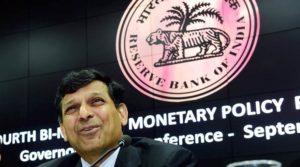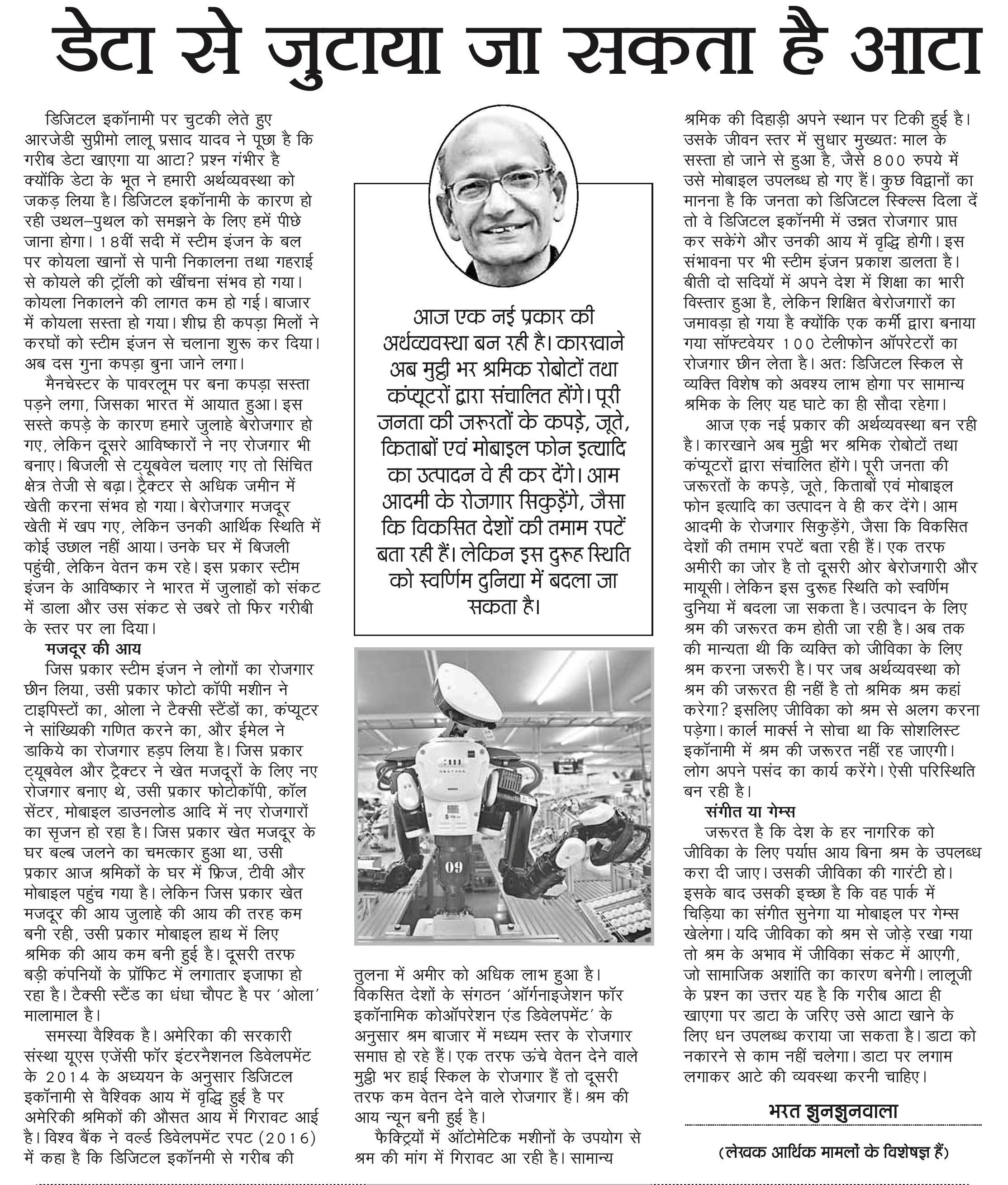
26-09-2016 (Important News Clippings)
Save the IIMs
Forcing top tier institutions to reserve faculty jobs will hurt higher education
The quality of a country’s human capital determines how well it does. Only India believes it can be an exception. There is no other way to make sense of the government’s decision to enforce reservation in faculty jobs in IIMs, after it had ordered IITs and central universities to toe the line. This is not going to help the Narendra Modi government’s stated goal of crafting a “regulatory architecture” to create 20 world class teaching and research institutions in India. Enforcing reservations in faculty jobs is a way of concealing governance failure at all levels in education.
There is a crisis in higher education and HRD minister Prakash Javadekar’s proposed solution will worsen matters. It should worry the government that the highest ranked Indian institution, IISc Bengaluru, is 147th in the QS World University rankings. Only one other institution, IIT Delhi, is ranked in the top 200. India needs to enhance the quality of its higher education and this can only be done by improving the work environment for faculty and opening it up to competition. Reservations do the very opposite by closing off competition. Moreover, reservations at faculty level are tantamount to an admission that reservations at lower levels have failed in equalising opportunity. If a policy has failed to deliver results, why multiply its applications?Poor governance at school level and muddleheaded policies in higher education have hurt young people. To foster an environment of job creation, it is critical to produce employable Indians. This should be Javadekar’s motto. If at all, the last tier where reservations are permitted should be when students enter college. It is now time to roll back the reservations juggernaut, else caste agitations like the Maratha, Jat and Patel movements are India’s future.
No creationism works in higher education

The idea that it is possible to set up “world-class” universities is flawed. There is no way to ensure that a university is world class at inception. It may have the best infrastructure but the true measure of a university is the quality and quantity of knowledge it produces and disseminates. The most important input is faculty and the research they undertake and supervise determines the quality of the university. This, in turn, impacts the quality of students, quantum of research grants. This is an evolutionary process and cannot be achieved overnight. The focus should be on enabling an ecosystem.This requires overhauling the existing higher education regulatory mechanism. It needs to move away from an input-focused, inspection-driven system to one that focuses on outcomes. Universities must have functional and financial autonomy. The regulator needs to ensure that universities meet the floor of standards, live up to the claims they make, and ensure equity and access.Exempting the proposed world-class universities from the oversight of an ineffective regulator will not guarantee their success. Universities require an ecosystem to flourish. That requires overhauling the higher education sector, and the first step is a dynamic, responsive and effective regulator. The exercise will not be easy, and it will take time, but in the end it will be a system that is likely to lift all boats, not just a few.
जलवायु परिवर्तन वार्ता प्रतिरोध के साथ चर्चा
जलवायु परिवर्तन पर हमें अंतरराष्ट्रीय मंच पर आरोप-प्रत्यारोप का मुकाबला करना चाहिए साथ ही चर्चा में भी शामिल रहना चाहिए, ताकि हम आने वाली पीढिय़ों के लिए बेहतर विश्व सुनिश्चित कर सकें। बता रहे हैं नितिन देसाई
चुनौती बनता बुढ़ापा
वृद्ध लोग ज्ञान, कौशल और अनुभव की दृष्टि से मूल्यवान होते हैं। समाज का दायित्व बनता है कि ऐसी व्यवस्था बने कि उन्हें मुख्य धारा से जोड़ा जाए, उनका स्वस्तिभाव बना रहे और सामाजिक, शारीरिक, आध्यात्मिक और सांस्कृतिक दृष्टि से गतिशीलता का अवसर मिले
इक्कीसवीं सदी में एक मौन क्रांति जनसंख्या की संरचना को लेकर आ रही है। इसके तहत नियंतण्र स्तर पर एक गंभीर बदलाव आ रहा है, जिसमें वृद्धों की संख्या अन्य आयु वर्गों की तुलना में बढ़ती नजर आ रही है। बुढ़ाती जनसंख्या नियंतण्र प्रवृत्ति का रूप ले रही है। समाज की संस्थाओं के ताने-बाने में इसके फलस्वरूप बड़ी उठापटक मची हुई है। यह स्थिति अब विकसित और विकासशील दोनों ही तरह के देशों में दिख रही है। मनुष्य की अधिकतम आयु 120 वर्षो की मानी जाती है। मृत्यु का विचार डरावना होता है और हर कोई इससे भागता है, बचना चाहता है। वैसे दीर्घायु होना सामाजिक-आर्थिक प्रगति का द्योतक है। अच्छी चिकित्सा सुविधा, तकनीकी संसाधनों की उपलब्धता और अच्छे पोषण वाले आहार से ऐसा बदलाव आ रहा है। जन्म दर और मृत्यु दर में कमी आने के साथ इस तरह का बदलाव स्वाभाविक है।
जीवन का विस्तार बढ़ रहा है। भारत की औसत जीवन प्रत्याशा अब 68.89 वर्ष हो रही है (पुरु षों की 67.46 वर्ष और स्त्रियों की 72.61 वर्ष)। बुढ़ाना सामान्य, असामान्य या फिर सफलता वाला हो सकता है। सफल वार्धक्य तब कहेंगे, जब व्यक्ति की शारीरिक, मानसिक और सामाजिक सक्रियता अधिकतम स्तर पर बनी रहे। व्यक्तियों के बीच बुढ़ापा अलग-अलग ढंग से आता है। खुद एक व्यक्ति में भी बौद्धिक, सामाजिक और शारीरिक आदि विभिन्न क्षेत्रों में परिवर्तन भिन्न मात्रा में और भिन्न रूपों में आता है। सच तो यह है कि बुढ़ापा (एजिंग) जन्म के साथ ही शुरू हो जाता है और आजीवन चलता रहता है। हां, इसका रूप और तीव्रता बदलती रहती है। बाद में जो गिरावट आती है, उसके अनेक कारण होते हैं। मसलन जीवन शैली, शिक्षा, व्यवसाय, बौद्धिक और सांस्कृतिक कार्यकलाप, तनाव, सामाजिक भागीदारी आदि। परिवेश से मिलने वाले और व्यक्ति द्वारा चुने गए, दोनों तरह के तत्व काम करते हैं। यदि व्यक्ति जीवन विस्तार में अधिकतम रूप से व्यवस्थित न किया जाए तो वृद्धावस्था में जोखिम बढ़ जाता है और व्यक्ति मधुमेह, स्मृतिलोप, मस्तिष्क आघात और सामाजिक अलगाव आदि से ग्रस्त हो जाता है। इसलिए केवल ‘‘सुखायु’ नहीं बल्कि ‘‘हितायु’ भी होनी चाहिए। व्यक्ति को अपने जीवन में लोक कल्याण को भी जगह देनी चाहिए।आम तौर पर वृद्धों को लेकर कई गलत धारणाएं प्रचलित हैं, जैसे बुद्धि और सर्जनात्मकता कम होना या अवसादग्रस्त होना आदि। अक्सर उन्हें बीमार और असहाय माना जाता है। वे समाज पर भार स्वरूप होते हैं। पर वृद्ध लोग ज्ञान, कौशल और अनुभव की दृष्टि से मूल्यवान होते हैं। समाज का दायित्व बनता है कि ऐसी व्यवस्था बने कि उन्हें मुख्य धारा से जोड़ा जाए, उनका स्वस्तिभाव बना रहे और सामाजिक, शारीरिक, आध्यात्मिक और सांस्कृतिक दृष्टि से गतिशीलता के अवसर मिले। उनकी मूलभूत आवश्यकताओं की पूर्ति हो, जीवन में उद्देश्य दिखे, वे सेवा करें, उनके सामने लक्ष्य रहे और सफलता की अनुभूति हो। वे आत्मनिर्भर जीवन जिएं जन कल्याण में योगदान दें। संयुक्त परिवार के टूटने से सामाजिक संरचना बदली है। एकल परिवारों में वृद्धों को स्थान नहीं मिलता है। अत: आर्थिक सुरक्षा, स्वास्य, आवास आदि की व्यवस्था द्वारा वृद्धों की भागीदारी के मार्ग में आने वाली बाधाएं दूर कर उन्हें संलग्नता और गरिमा के साथ भागीदारी का अवसर दिया जाना आवश्यक है। वृद्धावस्था में सफल जीवन के लिए जीने की शैली, सजग मानसिकता, तनाव प्रबंधन, अपनी देखभाल स्वयं करना, सहयोग प्राप्त करना, शारीरिक कार्य से जुड़े रहना, नियमित स्वास्य की जांच आदि के लिए मानव संसाधन में निवेश जरूरी होगा। संख्या और अनुपात में वृद्ध जन बढ़ रहे हैं। ऐसे में हमें यह विचार करना होगा कि वृद्ध व्यक्ति को किस तरह सामान्य जीवन का हिस्सा बनाया जाए? उसकी भूमिका क्या हो? उनका अकेलापन और अलगाव कैसे दूर करें? पीढ़ियों की परस्पर निर्भरता को कैसे स्थापित करें? यह जरूरी है कि वृद्ध जनों को कठिन परिस्थिति में भी डटे रहने, सामाजिक सम्बन्धों को जिलाए रखने, अपने में आत्मविास और आशावादिता लाने और सीमाओं के साथ जीने के लिए सरकारी और गैर सरकारी हस्तक्षेप जरूरी है। इस तरह की सठती लाने के लिए समाज के स्तर पर सोच बदलनी होगी और व्यवस्था का पुनराविष्कार करना होगा, जिसमें वृद्ध को मुख्य धारा का सक्रिय अंग बनाया जा सके।
प्रसंगवश
गिरीश्वर मिश्र
Six wise persons
Constitution of monetary policy committee promises an institutional arrangement more transparent, accountable.

Mumbai: RBI Governor Raghuram Rajan during a press conference announcing the RBI monetary policy at RBI Headquarters in Mumbai.
The formal constitution of a Monetary Policy Committee (MPC), which will decide on the Reserve Bank of India’s benchmark interest rates, ends an over seven-decade-long tradition that vested this power with the governor. The three academic economists appointed by the Centre will join three representatives from the RBI to the MPC, with the governor being only one out of the six responsible for setting the central bank’s policy rates. The current governor, Urjit Patel, is known to keep a low profile, unlike his illustrious predecessor, Raghuram Rajan, and, to that extent, may seem to fit more easily into the new institutional arrangement where the governor, while having a casting vote in the event of a tie, cannot veto a majority decision.
This is welcome, given the inherent inadvisability of vesting absolute power in any institution with a single person, howsoever eminent he or she may be. The existing system for monetary policy formulation did provide for a Technical Advisory Committee. But its advice was not binding on the central bank.
The MPC — which may well decide whether interest rates are to be cut or not in the next policy review on October 4 — has its work cut out. On the face of it, its mandate is simple — to implement the new framework agreement mandating the central bank to achieve a retail inflation target of four per cent, plus or minus two percentage points. But that is easier said in a country where a significant chunk of inflation has to do with food prices, on which there is not much that monetary policy can do.Nor is there clarity on what failure to meet the target would entail — apart from sending a report to the Centre stating reasons and the proposed remedial actions. Can the RBI — or the MPC, in this case — do anything about inflation that is also a result of fiscal profligacy or poor supply management at the level of the Centre and states?
But having said that, an MPC should still lead to a more transparent method of determining interest rates, based on the opinion of not one, but six wise persons. That, within a modern monetary policy framework, should also ensure more accountability when it comes to delivering on inflation. Such accountability in other countries such as the US — which has a 12-member Federal Open Market Committee, of which seven are selected by the US President and also ratified by the senate — extends to bringing in legislative oversight on policy-making. It would be interesting to see how the new MPC evolves in India.If the contribution of external experts adds more credibility to the process of interest rate setting — and this is complemented by regular consultation between Mint Street and North Block on coordination of monetary and fiscal policy actions — there could be no better collateral outcome from the new institutional arrangement.
समझौते के सामने
उड़ी में हुए आतंकी हमले में जिस तरह देश के अठारह फौजियों की जान गई, उसे आतंक के स्रोतों के प्रति भारत के जरूरत से ज्यादा उदार रवैये के नतीजे के तौर पर भी देखा गया। मगर इस बार देश भर में जो आक्रोश पैदा हुआ, उसके असर से सरकार खुद को निरपेक्ष नहीं रख सकती थी। इसलिए अगर सुरक्षा के मामले में उच्च स्तरीय बैठकों में इस मसले पर अपनाई जाने वाली रणनीति और कूटनीति में पाकिस्तान को अलग-थलग करने की कोशिश से लेकर भारत और पाकिस्तान के बीच अतीत में किए गए समझौतों पर इसका असर पड़ रहा है तो यह स्वाभाविक है। यही वजह है कि भारत ने 1960 में दोनों देशों के बीच हुए सिंधु जल समझौते से अलग होने के संकेत दिए हैं। इस समझौते के तहत दोनों देशों के बीच पानी के बंटवारे की मौजूदा व्यवस्था अगर किन्हीं हालात में टूटती है तो इसका पाकिस्तान को व्यापक नुकसान उठाना पड़ सकता है।
गौरतलब है कि ब्रिटिश सत्ता से आजादी के बाद जब पाकिस्तान के सामने पानी का संकट गहराने लगा और उसे लगा कि युद्ध की स्थिति में उसका पानी रोका जा सकता है, तो उसने भारत से गुहार लगाई और अंतरराष्ट्रीय सहयोग हासिल करने की कोशिश शुरू कर दी। फिर 1960 में विश्व बैंक की मध्यस्थता के बाद दोनों देशों के बीच सिंधु जल समझौता हुआ, जिसके तहत तीन पूर्वी नदियों- व्यास, रावी और सतलुज पर भारत का नियंत्रण है, वहीं तीन पश्चिमी नदियों- सिंधु, चेनाब और झेलम के ज्यादातर पानी पर पाकिस्तान का हक है। पाकिस्तान के सामने समस्या यह है कि उसके अधिकार वाली नदियां भी भारत के जम्मू-कश्मीर से होकर ही वहां जाती हैं। इसके बावजूद समझौते के मुताबिक भारत सिंधु नदी का केवल बीस फीसद पानी इस्तेमाल कर सकता है, जबकि करीब अस्सी फीसद पानी पाकिस्तान को मिलता है। यही वजह है कि इसे दुनिया का सबसे उदार समझौता माना जाता है।
पाकिस्तान की ओर से बार-बार समस्या खड़ी करने से लेकर आतंकवादियों को शह और शरण देने को लेकर भारत में यह मांग अक्सर उठती रही है कि पाकिस्तान को अपने यहां के आतंकी शिविरों को खत्म करने के लिए बाध्य करने के मकसद से सिंधु जल समझौता रद्द कर देना चाहिए। पर इस समझौते के मानवीय पहलू के मद्देनजर कई बार हालात बहुत संवेदनशील और तनावपूर्ण हो जाने के बावजूद भारत ने यह सख्त कदम नहीं उठाया। दरअसल, पाकिस्तान का करीब पैंसठ फीसद भौगोलिक क्षेत्र सिंधु नदी घाटी का हिस्सा है। इस इलाके में सिंचाई, कृषि, ऊर्जा उत्पादन से लेकर पेयजल तक की व्यवस्था का अधिकतर हिस्सा सिंधु पर ही निर्भर है और इस नदी को पाकिस्तान की जीवन रेखा कहा जाता है। यानी अगर इस मसले पर भारत ने कोई सख्त रुख अख्तियार किया और समझौते को रद्द करने का फैसला किया, तो पाकिस्तान के सामने खड़ी होने वाली समस्या का अंदाजा लगाया जा सकता है। मगर यह समझना मुश्किल है कि इतनी बड़ी निर्भरता होने के बावजूद पाकिस्तान का रवैया इस कदर भारत को परेशान करने वाला क्यों बना हुआ है। ऐसे तथ्य बार-बार सामने आते रहे हैं कि भारत में आतंकवाद की समस्या अगर इस कदर सिर चढ़ कर बोल रही है तो इसके पीछे आतंकियों को पाकिस्तान की ओर से मिलने वाली सहायता और समर्थन है। लेकिन भारत हो या कोई और देश, कब तक अपने खिलाफ ऐसी गतिविधियों को बर्दाश्त कर सकता है।
नदी की धार
कूटनीति में हर चीज साफ-साफ बताई नहीं जाती- नई दिल्ली में विदेश मंत्रालय के प्रवक्ता का इतना ही कहना जैसे काफी था। उसके बाद से अटकलों की बाढ़ आ गई है। भारत से बहकर पाकिस्तान जाने वाली छह बड़ी नदियों में इस दौरान जितना पानी नहीं बहा होगा, उससे ज्यादा शक-शुबहे और आशंकाएं बहने लगी हैं। यह उन नदियों की बात है, जिनके पानी के बंटवारे की संधि 1960 में ही हो गई थी और भारत-पाकिस्तान के बीच लगातार तनाव और युद्धों के बावजूद यह चलती रही, यहां तक कि युद्ध के दौरान भी यह लागू रही। इस संधि को दो तरह से देखा जाता है। एक तरफ, कुछ लोग इसे दो तनावग्रस्त देशों के बीच हुए एक आदर्श समझौते के रूप में देखते हैं, तो दूसरी तरफ, कुछ लोगों का मानना है कि दरिया के पानी की यह संधि एक समझौता कम है और भारत की दरियादिली का उदाहरण ज्यादा।
इस समझौते के तहत भारत को जितना पानी पाकिस्तान को देना चाहिए, वह उससे ज्यादा पाकिस्तान के हवाले कर देता है। इस संधि के तहत भारत सिंधु, चेनाब और झेलम के 20 फीसदी पानी का इस्तेमाल और भंडारण कर सकता है, लेकिन भारत ने इसके इस्तेमाल की कोई पक्की व्यवस्था तक नहीं बनाई, इसलिए सारा पानी बहकर पाकिस्तान चला जाता है। भारत ने इसके लिए बगलिहार और किशनगंगा की दो विद्युत परियोजनाएं जरूर बनाई हैं, जिनके खिलाफ पाकिस्तान अंतरराष्ट्रीय पंचाट में चला गया था, जहां पर उसे कुछ भी हासिल नहीं हुआ।
अब जब दोनों देशों का तनाव सब्र की सारी हदें पार कर गया है, तो यह सवाल उठ रहा है कि क्या पाकिस्तान को सबक सिखाने के लिए भारत को पानी रोक लेना चाहिए? पिछले कुछ दिनों से रक्षा विशेषज्ञ और राजनयिक भारत सरकार को जो तरह-तरह की सलाहें दे रहे हैं, उनमें यह एक प्रमुख सलाह है। यह भी कहा जा रहा है कि युद्ध से पाकिस्तान को उतना परेशान नहीं किया जा सकता, जितना उसका पानी रोककर किया जा सकता है। यह सच है कि अगर भारत नदियों से बहकर जाने वाले पानी की मात्रा कम कर दे, तो पाकिस्तान के एक बड़े इलाके में सूखा पड़ सकता है। हालांकि सरकार ने अभी यह साफ-साफ नहीं कहा कि वह ऐसा करने जा रही है, लेकिन उसने इससे इनकार भी नहीं किया है। एकाएक यह करना शायद आसान भी नहीं होगा, पानी को रोकने और उसके उपयोग के इंतजाम करने में समय लग सकता है। फिर भारत की दुनिया में यह छवि रही है कि वह जिन संधियों पर हस्ताक्षर करता है, उनका ईमानदारी से पालन भी करता है। सरकार को भी यह तय करना होगा कि क्या वह इस छवि को तोड़ना चाहेगी? हालांकि यह भी सच है कि इस तरह की संधियां शांति के लिए होती हैं, और जब शांति भंग होती है, तो इनका कोई अर्थ नहीं रहता।
सच तो यह है कि भारत और पाकिस्तान का जो भूगोल है, वह दोनों देशों को शत्रु बनने से रोकता है। बल्कि यह भी कहा जाता है कि यह भूगोल एक ही संस्कृति और एक ही समाज के लिए बना है। किसी ऐतिहासिक कारण से यह भूगोल दो देशों में बंट गया है, और ये दोनों देश अब आपसी सहयोग की बुनियाद पर ही आगे बढ़ सकते हैं। यही वह बात है, जिसे पाकिस्तान कभी नहीं समझ सका, वह भारत को हरदम नुकसान पहुंचाने की युद्ध-प्रिय मानसिकता में जी रहा है। यही वजह है कि नदियों का ज्यादातर पानी हासिल करने के बाद भी वह विकास के पैमाने पर काफी पिछड़ा है और विदेशी मदद के भरोसे ही जी रहा है। अगर वह अपनी इस मानसिकता और आतंकवाद को शह देने वाले रवैये को नहीं बदलता, तो आने वाले दिनों में पानी ही नहीं, उसे और कई परेशानियों का सामना करना पड़ सकता है।





